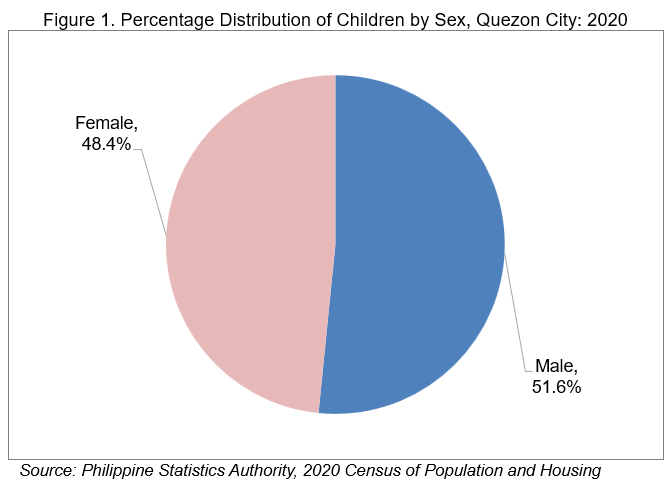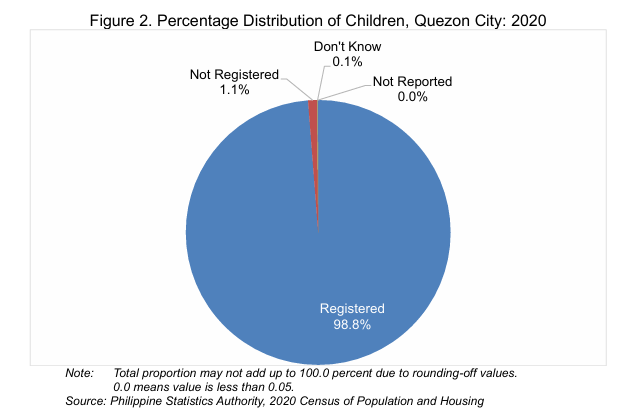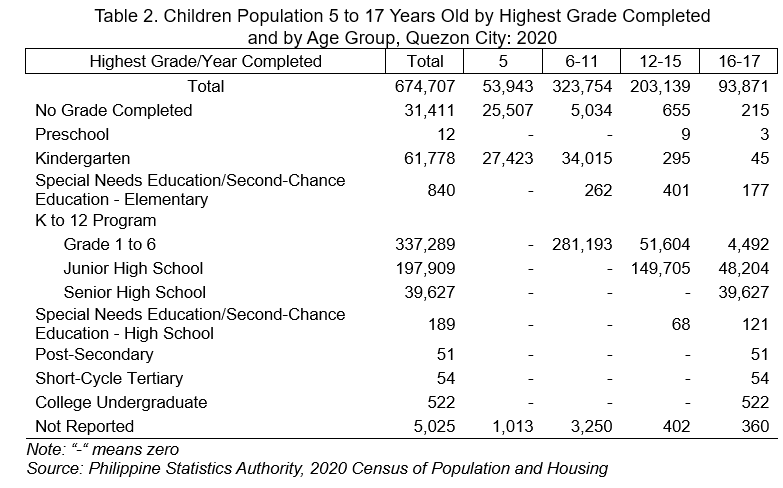A child is defined as an individual whose age is less than 18 years.
Male children outnumbered females
Based on the 2020 Census of Population and Housing (CPH) results, Quezon City had a total population of 965,831 children. The total population comprises 498,301 or 51.6 percent males—slightly outnumbering 467,530 females or 48.4 percent—resulting in a sex ratio of 107 males for every 100 females.
Figure 1 illustrates the percentage of children by sex in Quezon City for 2020.

At the barangay level, Barangay Commonwealth registered the highest child population with 78,751 or 8.2 percent, followed by Batasan Hills, with 57,632 or 6.0 percent. Meanwhile, Barangay Bayanihan had the smallest child population with 144 or 0.01 percent.
Five in every 1,000 boys and girls married before reaching the age of 18
In 2020, 4,564 children in the city married at a young age, which is 0.5 percent of that population, while 7,772 were common-law or in a live-in setup.
On the other hand, 241, or 0.2 percent of the population, have been divorced, separated, or annulled. Additionally, 57, or 0.01 percent, lost their wife or husband through death.
The remaining 70 accounted for children whose marital status was unknown.

Birth registration among children in the city is notably high
Quezon City had a positive birth registration count of 954,079 or 98.8 percent, but there were 10,647 or 1.1 percent unregistered births. On the other hand, over 700 (0.8 percent) don’t know if their births are registered while around 300 (0.4) people had no report.
Figure 2 depicts the distribution of children by birth registration in Quezon City for 2020.

Communicating using customary language records as severe functional difficulty among children
There are six core indicators of functional difficulty among children namely: (a) seeing even if wearing eyeglasses; (b) hearing even if using a hearing aid; (c) walking or climbing steps; (d) remembering or concentrating; (e) self-caring; and (f) communicating using his/her usual customary language.
Based on the 2020 CPH, communicating using his/her usual customary language recorded the highest severity among the six indicators. With a total case of 662 or 0.1 percent, followed by self-caring, with 393 cases or 0.1 percent. Next is walking or climbing steps with 271 cases or 0.04 percent and remembering or concentrating with 270 cases or 0.04 percent. Meanwhile, seeing even if wearing eyeglasses record 202 cases or 0.03 percent. On the other hand, the lowest functional difficulty among children records 195 cases or 0.03 percent go to hearing even if using a hearing aid.
Basic literacy rate slightly higher among female children
In Quezon City, 674,707 children (95.2%) aged five to 17 years old can read and write simple messages. Among the male children, basic literacy rate was 95.2 percent while a slightly higher rate of 95.3 was observed among female population.
Majority of Children Aged 5 to 17 Attained Grade-Level Education
In 2020, 638,271 (94.6%) of children aged five to 17 completed and had reached or completed a grade level. However, 31,411 children had not completed any grade, while data for others were not reported.
Half the number of children aged five (27,423, or 50.8%) in Quezon City had reached or completed early childhood education. Among those aged 6 to 11, 86.9 percent had reached or completed elementary education under the K to 12 Curriculum. Meanwhile, three in every four children aged 12 to 15 (203,139 or 73.7%) had reached or completed junior high school.
On the other hand, about two in every five (39,627 or 42.2%) children aged 16 to 17 have reached or completed senior high school (SHS).

Almost 140,000 children are OFWs
The number of children aged who work overseas was recorded at 1,398 individuals, representing 0.14 percent of the children’s population ages 15 to 17 years in the city. The total includes 685 or 49.0 percent in males and 713 or 51.0 percent in females.
HELEN L. ADOLACION
Chief Statistical Specialist
JGA/BBC
